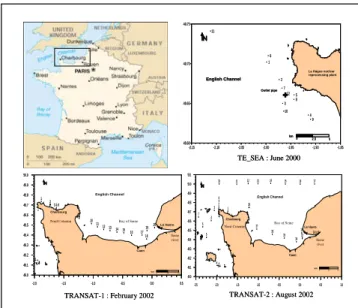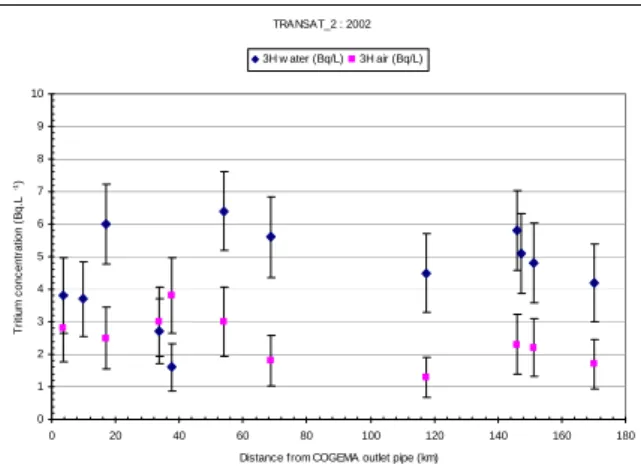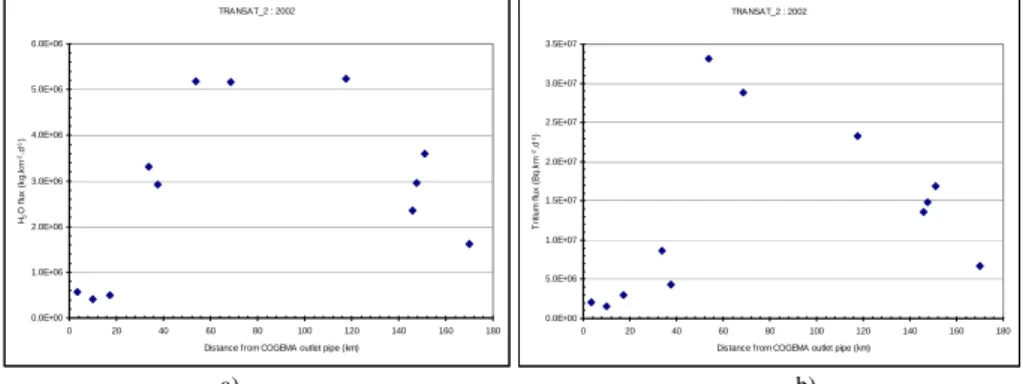HAL Id: hal-02504776
https://hal.archives-ouvertes.fr/hal-02504776
Submitted on 18 Feb 2021HAL is a multi-disciplinary open access
archive for the deposit and dissemination of sci-entific research documents, whether they are pub-lished or not. The documents may come from teaching and research institutions in France or abroad, or from public or private research centers.
L’archive ouverte pluridisciplinaire HAL, est destinée au dépôt et à la diffusion de documents scientifiques de niveau recherche, publiés ou non, émanant des établissements d’enseignement et de recherche français ou étrangers, des laboratoires publics ou privés.
Tritium transfer between sea and atmosphere in the
English Channel (North Cotentin and Bay of Seine)
D. Maro, L. Tenailleau, M. Fontugne, P. Germain, D. Hébert, M. Rozet
To cite this version:
D. Maro, L. Tenailleau, M. Fontugne, P. Germain, D. Hébert, et al.. Tritium transfer between sea and atmosphere in the English Channel (North Cotentin and Bay of Seine). Radioprotection, EDP Sciences, 2005, 40, pp.S589-S594. �10.1051/radiopro:2005s1-086�. �hal-02504776�
DOI: 10.1051/radiopro:2005s1-086
Tritium transfer between sea and atmosphere in the English
Channel (North Cotentin and Bay of Seine)
D. Maro
1, L. Tenailleau
2, M. Fontugne
3, P. Germain
1, D. Hébert
1and M. Rozet
11
Institut de Radioprotection et de Sûreté Nucléaire, Laboratoire de Radioécologie de Cherbourg-Octeville, 50130 Cherbourg-Octeville, France
2
Marine Nationale, Groupe d'Études Atomiques, BP. 34, 50115 Cherbourg Naval, France
3
Laboratoire des Sciences du Climat et de l'Environnement, UMR 1572-CEA/CNRS, Domaine du CNRS, 91198 Gif-sur-Yvette, France
Abstract. Oceans, seas, estuaries and rivers represent a vast sink for many substances of anthropic origin
(metals, radionuclides, etc…). Depending on their chemical form, artificial radionuclides discharged into the sea by the nuclear industry can be carried onto land in marine aerosols, as well as by degassing
seawater as is the case for tritium (3H) or for radiocarbon (14C). Three oceanographic cruises in the
English Channel: TE-SEA, TRANSAT 1 and 2 have been performed on R.V. "Côtes de la Manche" to
quantify the flux of 3H in gaseous form, from the sea into the atmosphere, following particular discharge
into the sea from the COGEMA spent fuel reprocessing plant at La Hague (North West France). During
cruises, the maximum concentration measured in the air was 10.6 Bq.L-1, which is distinctly higher than
the background of 1 Bq.L-1 thus demonstrating the transfer of 3H between water and atmosphere. The
mean flux of 3H between the water and the atmosphere, calculated during these cruises was 2.4 107 Bq.km-2.d-1.
For the Seine Bay area (4400 km2) this flux represents 39 TBq.yr-1 and hence less than 0.3 % of 3H
discharged into the ocean from the COGEMA spent fuel reprocessing plant at La Hague.
1. INTRODUCTION
Oceans, seas, estuaries and rivers represent a vast sink for many substances of anthropic origin (metals, radionuclides, etc…). Depending on their chemical form, artificial radionuclides discharged into the sea by the nuclear industry can be carried onto land in marine aerosols, as well as by degassing seawater as is the case for tritium (3H) or for radiocarbon (14C) [1, 2]. Knowledge of these exchanges should lead to quantification of the radioactivity discharged into the atmosphere then transferred into the soil and plants and to man. In June 2000 and February and August 2002, the Laboratoire de Radioécologie de Cherbourg-Octeville (LRC, Cherbourg, France) in association with the Laboratoire des Sciences du Climat et de l’Environnement (LSCE, Gif sur Yvette, France) and the French Navy Groupe d’Etudes Atomiques (GEA, Cherbourg, France), carried out oceanographic cruises TE-SEA, TRANSAT 1 and 2 on the R.V. "Côtes de la Manche", to quantify the flux of gaseous 3H from the sea into the atmosphere, between the point of discharge into the ocean from the COGEMA spent fuel reprocessing plant at La Hague and the Seine estuary. This paper presents the results of these cruises.
S590 RADIOPROTECTION
2. EQUIPMENT AND METHOD 2.1 Method
Discharge into the ocean from the COGEMA spent fuel reprocessing plant at La Hague (Nord Cotentin, France) is the main source of 3H in the English Channel [3]. For example, in 2002, this plant discharged 1.2 1016 Bq.yr-1 of 3H into the sea and during the same year, atmospheric discharge was 6.3 1013 Bq.yr-1 of 3H [4].
To evaluate the transfer of 3H between water and atmosphere due to discharge into the sea by COGEMA La Hague, the flux of water vapour (L.m-2.d-1) is calculated first, using Rohwer's formula [5]:
Φ(H2O) = 0.372 (1-0.000374 Pa) (1+0.6 Vw) (es-ea) (1)
where:
Φ(H2O) : Flux of water vapour (L.m-2.d-1),
Pa : Atmospheric pressure (mbar),
Vw : Wind speed (m.s-1),
es : Saturated vapour pressure (mbar),
ea : Vapour pressure in the atmosphere (mbar).
Then, knowing the concentration of 3H in the water, the flux of 3H (Bq.m-2.d-1) is determined using equation 2: Φ(3
H2O) = Φ(H2O) [3Hw] (2)
where: Φ(3
H2O) : Flux of 3H between water and atmosphere (Bq.m-2.d-1),
[3Hw] : Concentration of 3H in the water (Bq.L-1).
2.2 Sampling of seawater and air
In 2000 and 2002, three oceanographic cruises were carried out with the INSU/CNRS Oceanographic Vessel "Côtes de la Manche" (figure 1) between 1 and 4 June 2000 (TE_SEA) and between the 24 and 28 February 2002 (TRANSAT 1) and 27 to 31 August 2002 (TRANSAT 2).
-2.0 -1.5 -1.0 -0.5 0.0 0.5 49.0 49.1 49.2 49.3 49.4 49.5 49.6 49.7 49.8 49.9 50.0 1 2 3 à 8 9 10 1112 13 1415 16 17 18 1920 0 10 20 Cherbourg Le Havre Caen km English Channel -2.5 -2.0 -1.5 -1.0 -0.5 0.0 0.5 1.0 49.0 49.1 49.2 49.3 49.4 49.5 49.6 49.7 49.8 49.9 50.0 50.1 1 2 3 4 5 6 7 8 9 10 11 12 13 14 15 16 17 18 19 20 à 33 34 35 36 37 38 0 10 20 Cherbourg Le Havre Caen km English Channel
TRANSAT-1 : February 2002 TRANSAT-2 : August 2002
TE_SEA : June 2000 Bay of Seine Seine river Seine river Bay of Seine -2.15 -2.10 -2.05 -2.00 -1.95 -1.90 -1.85 49.60 49.65 49.70 49.75 1 2 3 4 5 6 7 8 9 10 11 12 La Hague nuclear reprocessing plant Outlet pipe km English Channel 0 0.05 0.1 0 2.5 5 Nord Cotentin Nord Cotentin -2.0 -1.5 -1.0 -0.5 0.0 0.5 49.0 49.1 49.2 49.3 49.4 49.5 49.6 49.7 49.8 49.9 50.0 1 2 3 à 8 9 10 1112 13 1415 16 17 18 1920 0 10 20 Cherbourg Le Havre Caen km English Channel -2.5 -2.0 -1.5 -1.0 -0.5 0.0 0.5 1.0 49.0 49.1 49.2 49.3 49.4 49.5 49.6 49.7 49.8 49.9 50.0 50.1 1 2 3 4 5 6 7 8 9 10 11 12 13 14 15 16 17 18 19 20 à 33 34 35 36 37 38 0 10 20 Cherbourg Le Havre Caen km English Channel
TRANSAT-1 : February 2002 TRANSAT-2 : August 2002
TE_SEA : June 2000 Bay of Seine Seine river Seine river Bay of Seine -2.15 -2.10 -2.05 -2.00 -1.95 -1.90 -1.85 49.60 49.65 49.70 49.75 1 2 3 4 5 6 7 8 9 10 11 12 La Hague nuclear reprocessing plant Outlet pipe km English Channel 0 0.05 0.1 0 2.5 5 Nord Cotentin Nord Cotentin
The sampling periods reflect roughly the different meteorological patterns encountered during the year. To avoid being under the atmospheric plume of the COGEMA La Hague plant, samples were taken upwind of the plant. During the cruises, close to COGEMA La Hague (< 50 km), the activity of krypton 85 (85Kr), a gas discharged by the plant into the atmosphere at the same time as 3H, was also measured continuously at one second intervals in order to verify the presence of atmospheric plume. The presence of 85Kr discharged from the plant stack was detected immediately [6]. Samples for measuring
3
H in the air and seawater were therefore taken when the influence of the plant plume was undetectable. Seawater was sampled after filtration at 0.45 µm on the surface, in one litre polyethylene flasks. The water vapour was condensed on a cold trap (PREVAIR system) developed specifically by IRSN (LRC) for this study in association with the French Navy (GEA). This sampling system allows the limit of detection to be lowered when measuring 3H by a factor of 3000 compared with sampling systems using bubble tubes. This sampling, which takes about fifteen minutes, was performed two metres above the surface of the water.
Water temperature and salinity were measured with a Seabird SBE 19-03 probe. Air temperature, humidity, atmospheric pressure, wind speed and direction were measured using the "Côtes de La Manche" meteorological station (Young equipment).
2.3 Measurement of 3H
The seawater was purified by distillation to eliminate any radionuclides which could interfere with measuring 3H. The distilled seawater samples and water vapour samples from the air were mixed with a scintillating liquid in a standard metering flask before being transferred to a liquid scintillation counter for measurement. Measurements were made in the French Navy's low background laboratory at Cherbourg (Roule Laboratory).
3. RESULTS AND DISCUSSION
3.1 Concentrations of 3H in seawater and atmospheric water vapour
The concentrations of 3H in the seawater and atmospheric water vapour measured during the TE-SEA and TRANSAT 1 and 2 cruises are presented in figures 2 to 4.
The mean concentrations measured in seawater were 14.8 Bq.L-1 (maximum 20.9 Bq.L-1) during TE-SEA, 5.7 Bq.L-1 (maximum 13.3 Bq.L-1) during TRANSAT 1 and 4.5 Bq.L-1 (maximum 6.4 Bq.L-1) during TRANSAT 2. In comparison with the background in 3H, around 0.15 Bq.L-1 at the entrance to the Channel, these measurements indicate industrial seawater labelling by mainly the COGEMA La Hague spent fuel reprocessing plant [7]. For the same points, the mean concentrations measured in atmospheric water vapour were 7.0 Bq.L-1 (maximum 10.1 Bq.L-1) during TE-SEA, 2.8 Bq.L-1 (maximum 4.8 Bq.L-1) during TRANSAT 1 and 2.4 Bq.L-1 (maximum 3.8 Bq.L-1) during TRANSAT 2. In comparison with the 3H background, below 1.0 Bq.L-1 in air, these measurements indicate air labelling [3]. Since the samples were taken upwind, outside the atmospheric plume from the COGEMA La Hague plant, these results demonstrate that 3H is transferred from the water into the atmosphere by evaporating seawater.
The highest concentrations in the air were measured during the TE-SEA cruise in an area close to the COGEMA La Hague plant ocean discharge point. In general, for all the cruises, the evolution of concentrations in the air follows the evolution of concentrations in water. The observed differences are due to different meteorological conditions at the time, wind speed and air hygrometry.
S592 RADIOPROTECTION TE-SEA : 2000 0 5 10 15 20 25 0 2 4 6 8 10 12 14 16
Distance from COGEMA outlet pipe (km)
T ri tiu m c onc entr a tion ( B q. L -1) 3H w ater (Bq/L) 3H air (Bq/L)
Figure 2. Variation of 3H activities (Bq.L-1) in surface seawater and air versus distance from COGEMA outlet pipe during TE-SEA cruise.
TRANSAT_1 : 2002 0 2 4 6 8 10 12 14 16 0 20 40 60 80 100 120 140 160
Distance f rom COGEMA outlet pipe (km)
T ri tiu m c onc entr a tion ( B q. L -1) 3H w ater (Bq/L) 3H air (Bq/L)
Figure 3. Variation of 3H activities (Bq.L-1) in surface seawater and air versus distance from COGEMA outlet
pipe during TRANSAT 1 cruise.
TRANSAT_2 : 2002 0 1 2 3 4 5 6 7 8 9 10 0 20 40 60 80 100 120 140 160 180
Distance f rom COGEMA outlet pipe (km)
T ri tiu m c onc entr a tion ( B q. L -1) 3H w ater (Bq/L) 3H air (Bq/L)
Figure 4. Variation of 3H activities (Bq.L-1) in surface seawater and air versus distance from COGEMA outlet pipe during TRANSAT 2 cruise.
3.2 Flux of 3H between water and atmosphere
The water vapour and 3H flux determined during the TE-SEA, TRANSAT 1 and 2 cruises are given in figures 5 to 7.
The mean water vapour flux measurements obtained during these cruises was 2.7 106 kg.km-2.d-1 (TE-SEA), 3.2 106 kg.km-2.d-1 (TRANSAT 1) and 2.8 106 kg.km-2.d-1 (TRANSAT 2), corresponding to a mean flux of 3H from water to atmosphere of 4.0 107 Bq.km-2.d-1 (TE-SEA), 2.0 107 Bq.km-2.d-1 (TRANSAT 1) and 1.3 107 Bq.km-2.d-1 (TRANSAT 2). Generally, 3H flux between water and atmosphere falls with distance from the discharge point, reflecting the dilution of liquid waste in the Channel waters. The mean flux was slightly higher during TE-SEA in the area close to the COGEMA La Hague point of discharge into the sea. During TRANSAT 1 the mean flux was higher than during TRANSAT 2 because the windspeed was higher (factor 2). The mean flux calculated for all the cruises was 2.4 107 Bq.km-2.d-1. Over an area corresponding to Seine Bay (4400 km2) the quantity of
3
H transferred into the atmosphere per year can be evaluated at 39 TBq i.e. 0.3 % of the quantity of 3H discharged into the sea in 2002 by the COGEMA La Hague plant.
TE-SEA : 2000 0.0E+00 5.0E+05 1.0E+06 1.5E+06 2.0E+06 2.5E+06 3.0E+06 3.5E+06 4.0E+06 4.5E+06 5.0E+06 0 2 4 6 8 10 12 14 16
Distance from COGEMA outlet pipe (km)
H2 O f lu x ( k g .km -2.d -1) TE-SEA : 2000 0.0E+00 1.0E+07 2.0E+07 3.0E+07 4.0E+07 5.0E+07 6.0E+07 7.0E+07 8.0E+07 0 2 4 6 8 10 12 14 16
Distance from COGEMA outlet pipe (km)
T rit iu m f lu x ( B q .k m -2.d -1) a) b)
Figure 5. Variation of water vapour fluxes (a) and 3H fluxes (b) versus distance from COGEMA outlet pipe
during TE-SEA cruise.
TRANSAT_1 : 2002 0.0E+00 1.0E+06 2.0E+06 3.0E+06 4.0E+06 5.0E+06 6.0E+06 7.0E+06 0 20 40 60 80 100 120 140 160
Distance from COGEMA outlet pipe (km)
H2 O f lu x ( k g .km -2.d -1) TRANSAT_1 : 2002 0.0E+00 5.0E+06 1.0E+07 1.5E+07 2.0E+07 2.5E+07 3.0E+07 3.5E+07 4.0E+07 4.5E+07 5.0E+07 0 20 40 60 80 100 120 140 160
Distance from COGEMA outlet pipe (km)
T rit iu m f lu x ( B q .k m -2.d -1) a) b)
Figure 6. Variation of water vapour fluxes (a) and 3H fluxes (b) versus distance from COGEMA outlet pipe
S594 RADIOPROTECTION TRANSAT_2 : 2002 0.0E+00 1.0E+06 2.0E+06 3.0E+06 4.0E+06 5.0E+06 6.0E+06 0 20 40 60 80 100 120 140 160 180 Distance from COGEMA outlet pipe (km)
H2 O f lux ( k g.k m -2.d -1) TRANSAT_2 : 2002 0.0E+00 5.0E+06 1.0E+07 1.5E+07 2.0E+07 2.5E+07 3.0E+07 3.5E+07 0 20 40 60 80 100 120 140 160 180 Distance from COGEMA outlet pipe (km)
T rit iu m f lu x ( B q .k m -2.d -1) a) b)
Figure 7. Variation of water vapour fluxes (a) and 3H fluxes (b) versus distance from COGEMA outlet pipe
during TRANSAT 2 cruise.
4. CONCLUSION
The oceanographic cruises TE-SEA, TRANSAT 1 and 2 performed in the English Channel revealed atmospheric labelling with 3H following the evaporation of seawater labelled with tritiated waste from the COGEMA La Hague spent fuel reprocessing plant. The mean flux of water vapour and 3H between water and atmosphere was evaluated respectively at 2.9 106 kg.km-2.d-1 and 2.4 107 Bq.km-2.d-1, which corresponds an annual quantity of 39 TBq transferred into the atmosphere by this process, i.e. 0.3 % of the quantity of 3H discharged into the sea in 2002 by COGEMA La Hague. This method must be generalised to provide a global estimate of the exchanges of 3H between water and atmosphere for the whole of the English Channel.
Acknowledgements
The authors thank Messrs Le Bar and Schgier, Mrs Fitamant and her team at COGEMA for helping us during these cruises. We also thank Messrs Le Bourhis and Henri, captains of the CNRS oceanographic vessel "Côtes de La Manche" and their crews.
References
[1] Fontugne M., Maro D., Baron Y., Hatté C., Hébert D. and Douville E., Identification of sources and distribution of radiocarbon in the vicinity of La Hague nuclear reprocessing plant, Radioprotection 37, C1 (2002) 1271-1276.
[2] Maro D., Fontugne M., Hatté C., Hébert D. and Rozet M., 14C sources and distribution in the vicinity of La Hague nuclear reprocessing plant: Part II-Marine environment, Radiocarbon 46, Nr 2 (2004), 831-839. [3] Maro D., Germain P., Calmet D., Fournier M., Le tritium dans l’environnement proche du site de
l’usine de retraitement de La Hague, Résultats des campagnes de prélèvements dans l’environnement marin et terrestre pour le district de La Hague, Rapport IPSN/DPRE/SERE 98/029 (1998), 17 p. [4] Surveillance trimestrielle de l’environnement de La Hague, quatrième trimestre, Rapport
HAG 006000320019 (2002), 63 p.
[5] Rohwer C., Evaporation from a free water surface, U.S. Dept. of Agr., Tech. Bull. (1931).
[6] Maro D., Germain P., Hebert D., Solier L., Rozet M., Leclerc G. and Le Cavelier S., Krypton 85: A tool for investigating near field atmospheric dispersion for elevated emissions around La Hague spent fuel nuclear reprocessing plant, 8Th Int. Conf. On Harmonisation within Atmospheric Dispersion Modelling for Regulatory purposes, Sofia, Bulgaria, 14-17 October 2002, E. Batchvarova and D. Syrakov Eds (2002), pp. 138-143.



